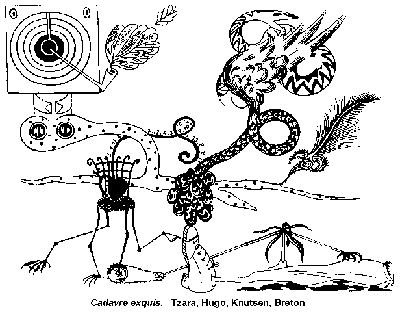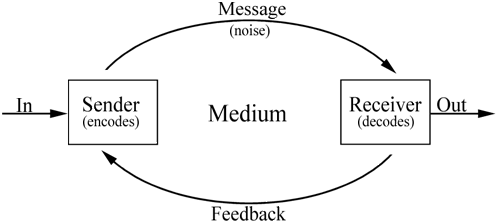other publications
Narrative Begins!
Remember those story telling games people used to play by passing the narrative (ball) from person to person around the room? An online narrative is a group collaborative composition that works just like this. You add your posting to the narrative thread begun and advanced by others. You can add to the "end" of the story by threading from the last posting, or you can interject a story element by replying to any previous threads. The medium allows the story to branch off at any point: some threads may proliferate, and others atrophy.
To begin, a participant describes an incident to initiate the story, purposely leaving the ending of the segment open to allow the next posting to continue and develop the narrative and characters. Subsequent postings can advance the story, establish a parallel narrative thread ("Meanwhile..."), or interject a flashback ("Looking back on what started all this off..."). Some postings might be descriptive interludes or character development that fill in details rather than advancing the plot. Characters, of course, can always travel to new places.
Itís possible that this collective narrative could turn into a kind of free-for-all, so I want to recommend a few general guidelines (similar to protocols of improvisation):
- All participants should take some responsibility for the coherence, and the tone and style of the narrative.
- To effect a change of style, ease into it, or project the narrative through the consciousness of another character.
- Try to provide the characters with some options or choices.
- Please donít kill off the main character!
- Avoid blocking the initiatives or leads of other participants; if you donít want to go in that direction, develop a parallel thread.
- To maintain the challenge of developing a story, let's avoid dream sequences as being too easy.
- If you are offended by someoneís writing or content, donít judge it. Move off in another direction, or devise a way for the offended character to experience some justice. Thereís no need to be politically correct--weíre not writing social policy. This is a story and people do wonderful and frightening things to one another every day.
- If you are so inclined, use humour, irony, and sarcasm to keep the mood of the story playful.
Weíll run the story for two weeks (Jan. 29 to Feb. 12) to give it some time to develop. During that time, to receive a maximum of 10 %, you need to post a minimum of 300 words (total) in at least two postings not on the same day. You will be evaluated on the quality of your writing, and your ability to advance the narrative in engaging, interesting ways.
Keep in mind that this is a collaborative creative endeavor, similar to a group musical improvisation: everyone in the ensemble must know how to make music with the other members--thatís a given--and everyone has an equal opportunity to solo by adding to the composition with a distinctive instrumental voice. Timing is important. Listen to the other players.
The inspiration for this assignment comes from the Surrealist drawing experiments called Cadavre Exquis--the exquisite corpse. Below is an example:

Identity and Performance in Cyberspace
Sherry Turkle's Who Am We?
Profile of Sherry Turkle by Pamela McCorduck: Sex, Lies and Avatars
Hyperlinks to Donna Haraway including "The Cyborg Manifesto"
Excerpt from How We Became Posthuman: Katherine Hayles argues that information and technology have ushered us into the posthuman era.
Sandy (Alluquère Rosanne) Stone's Homepage: theory and practice of shifting identities and genders.
When we interact in cyberspace, how is our sense of self affected? A growing body of critical writing suggests that travelling in cyberspace--whether we're using email, chat, surfing the web, or participating in online gaming--provides new conditions for the construction of identity. Some, like Sherry Turkle, claim that distributed networking leads to the perception that we are decentered, multiple selves, open to greater possibilities and variety; others such as Katherine Hayles and Donna Haraway argue that we have become so entangled in webs of information and technology that we have already become posthuman cyborgs. Whatever we might conclude about the nature of identity in cyberspace (very likely a personal conclusion), it seems clear that in cyberspace we are in a new performance medium. While we may still feel the same about ourselves, the stage has surely changed, and so have the guidelines for the actors.
In his excellent book Performance (Routledge, 1996), Marvin Carlson makes the following distinction about performance:
The recognition that our lives are structured according to repeated and socially sanctioned modes of behavior raises the possibility that all human activity could be considered as "performance," or at least all activity carried out with a consciousness of itself. The difference between doing and performing, according to this way of thinking, would seem to lie not in the frame of theatre versus real life but in an attitude--we may do actions unthinkingly, but when we think about them, this introduces a consciousness that gives them the quality of performance. (4)
Carlson suggests that when we are conscious of our actions, we are by definition performing. If we are conscious of projecting an identity--as when we are telling someone who we are and what we do--we are performing an identity. How does our interaction through the medium of the computer screen affect our performance of self?
The machine itself performs functions which require some knowledge and level of expertise from the user. We are performing with a communications tool. Through a variety of software applications, we attempt to make connections, and the way of writing may be adjusted depending on the software application: word processor, e-mail, newsgroup postings, chat lines, online games, or web-pages. This performance aspect is most intense and apparent in synchronous (real-time) on-line interactions such as chat forums and gaming. However, performance also figures strongly with asynchronous newsgroup postings and e-mail exchanges. We are performing ourselves through the expressive medium of the computer no matter what the pace and interval between the exchanges.

Models of the Self
Either consciously or unconsciously, most of us harbour a construction or model of the self which we hope will sustain us, or help us explain why things happen to us the way they do. Below are listed just a few of the 20th century models of the self and their theorists. (You can probably add many names of your own to this list.):
- Sigmund Freud: id, ego, superego
- Carl Jung: archetypes
- Wilhelm Reich: character armoring
- Erik Erikson: stages of maturation
- Victor Turner: rites of passage
- R. D. Laing: character attributions
- Myers-Briggs Personality Profile
- Erving Goffman: the self as actor
- Hakim Bey: the nomadic self, temporary autonomous zones
- Giles Deleuze: desiring machines, nomads
- Psychographic profiles
Think of the many ways our ideas of the self have been built up for us by parents, teachers, spiritual leaders, the media, and our own experience. Is the self relatively fixed and determined, or is it flexible, malleable, and capable of refashioning and reconfiguration?
Communication as Dialogue

The performative aspects of any communications medium are conditioned by the way it allows us to send and receive messages. We adjust our performance style, for example, while using the telephone, meeting someone face-to-face, or emailing a friend. We arm ourselves before we enagage in a heated session of online Quake. The resonance theory of communication asserts that the message is not something which is sent, but rather something created by the person who receives the stimulus. Thus, the identity of the person is instrumental to the outcome of the communication: the self is a matrix, or network, of impressions, experiences, degrees of receptivity, learning, concepts of identity, and cultural paradigms. In electronic environments where we generally write to make our selves known, text becomes our voice. How is this text related to the self?
The Russian literary theorist Bakhtin articulated the notion of dialogism, which he thought of as the simultaneous coexistence of competing discourses, or a dialogue between "voices" anticipating and answering one another. Imagine, for example, a discussion at a dinner table in which you define your own ideas by saying things like, "She said...," or "I read....." or "I heard on television..." This multitude of voices produces what has been called a heteroglossia: different voices speaking together to form a complexly layered dialogue. Every culture is, in effect, a mosaic of competing voices; likewise, every person is known through a collage of references to other texts.
Julia Kristeva, in her essay "Word, Dialogue, and Novel" (Desire in Language), uses the idea of dialogism--competing voices--to clarify the meaning of intertextuality where communication occurs at the intersection of texts and is not a point of fixed meaning. A literary text, for example, is a response to a previous text, often echoing that text with language or imagery, or even direct quotation. Think, for example, of the number of texts which have been based on the stories of the Bible, commonly-known myths, or fairy tales. The text becomes a dialogue among several writings. Bakhtinís insight, claims Kristeva, is that "any text is constructed of a mosaic of quotations; any text is the absorption and transformation of another [text]." Newsgroup discussion threads or the textual dialogue of chat illustrate this idea nicely.
If we extend the idea of intertextuality--different texts speaking to one another--to the concept of interactivity, we find that interaction is a (moving) point where dialogue crosses paths. Online writing might be defined as the electronic intersection of textual voices. Approaching the definition of the self from this textual angle emphasizes the idea that writing is a dialogue not merely between people, but between their texts. In the online environment, the self is constituted by the texts we display.
The Self as Host of Memes
Ideas can "infect" thinking just as viruses can invade the hard drive of a computer. Biologist Richard Dawkins--in his 1976 book The Selfish Gene--writes of self-reproducing ideas as "memes": ideas use human beings to reproduce themselves, and they compete, like genes, to replicate themselves. The word "meme" has recently been included in the Oxford English Dictionary where it is defined as a "self-replicating element of culture, passed on by imitation." "Just Do It" is a meme, as is "Christ died for our sins."
In her article "The Power of Memes" (Scientific American, October 2000: 65-73), Susan Blackmore makes the following comparison to clarify the definition of memes:
Memes and Complexes of Memes
Not Memes
|
To clarify the distinction between what is a meme and what is not, Blackmore suggests that memes are "copied from person to person and vie for survival in the limited space of human memories and culture" (66). Memes are not memes until they are transmitted. Culture is shaped by them, and the self is host to a variety of memes. Online communication is a fertile medium for memes--think of "LOL", or all the acronyms, jargon, and slang--partly because text is circulated so easily and quickly, and partly because, in the new medium, there are emerging models of interaction and emerging ideas about the self. The new medium is fertile and competitive.
The cartoon about the dog makes us laugh because we don't know who we are (with such certainty) when we're online, and we often just don't know who, or what, we're dealing with.
Who Am We? Self as Multiple Distributed System

MIT professor of sociology Sherry Turkle received a great deal of press in 1996 after the publication of her influential Life on the Screen: Identity in the Age of the Internet. A Wired magazine article on Turkle's work--"Who Am We?"--provides a decent summary of her approach in Life on the Screen:
What has she found? That the Internet links millions of people in new spaces that are changing the way we think and the way we form our communities. That we are moving from "a modernist culture of calculation toward a postmodernist culture of simulation." That life on the screen permits us to "project ourselves into our own dramas, dramas in which we are producer, director, and star.... Computer screens are the new location for our fantasies, both erotic and intellectual. We are using life on computer screens to become comfortable with new ways of thinking about evolution, relationships, sexuality, politics, and identity.Turkle's own metaphor of windows serves well to introduce the following samplings from her new book. Those boxed-off areas on the screen, Turkle writes, allow us to cycle through cyberspace and real life, over and over. Windows allow us to be in several contexts at the same time - in a MUD, in a word-processing program, in a chat room, in e-mail.
"Windows have become a powerful metaphor for thinking about the self as a multiple, distributed system," Turkle writes. "The self is no longer simply playing different roles in different settings at different times. The life practice of windows is that of a decentered self that exists in many worlds, that plays many roles at the same time." Now real life itself may be, as one of Turkle's subjects says, "just one more window." (Wired 149)
To illustrate her central idea in the article Who Am We? that computers decenter notions of the self, Turkle discusses Multi-User Dungeons or MUDs, "a new kind of social virtual reality":
...text-based Muds are a new form of collaboratively written literature. MUD players are MUD authors, the creators as well as consumers of media content. In this, participating in a MUD has much in common with scriptwriting, performance art, street theatre, improvisational theatre, or even commedia dellíarte. (151)
Turkle claims much more for MUDs: "As players participate, they become authors not only of text but of themselves, constructing new selves through social interaction." This claim has profound importance if we think of young people, who have not yet armored their characters (see Reich), constructing new models of flexible, changeable, adaptable selves.
MUDs imply difference, multiplicity, heterogeneity, and fragmentation. Such an experience of identity contradicts the Latin root of the word, idem, meaning "the same." But this contradiction increasingly defines the conditions of our lives beyond the virtual world. MUDs thus become objects-to-think-with for thinking about postmodern selves. (153)
Online interaction--including email, chat, gaming and MUDs--can become "laboratories for the construction of identity" (194). In this construction of identity, the principles of play--combining what is with what could be--move from the sandbox of the self to the theatre of virtual identity.
Allucquere Rosanne (Sandy) Stone
 "Sandy" Stone founded the actlab at the University of Texas (Austin) in 1992 to explore the "boundaries where technology, art, and culture collide." Stone's work and ideas are available through her homepage.
"Sandy" Stone founded the actlab at the University of Texas (Austin) in 1992 to explore the "boundaries where technology, art, and culture collide." Stone's work and ideas are available through her homepage.
Her book The War of Desire and Technology at the Close of the Mechanical Age is a fascinating series of stories which reflect on the way people perform identities on-line. From the MIT Press description of the book:
Face-to-face meetings, and even telephone conversations, involuntarily reveal crucial aspects of identity such as gender, age, and race. However, these bits of identity are completely masked by computer-mediated communications; all that is revealed is what we choose to reveal -- and then only if we choose to tell the truth. The rise of computer-mediated communications is giving people the means to try on alternative personae -- in a sense, to reinvent themselves -- which, as Stone compellingly argues, has both positive and potentially destructive implications. ...
Each chapter of the book can be read as a kind of performance piece, with its own individual voice and structure. In the final chapter, Stone threads the various narratives together, holding them in productive tension rather than attempting to collapse them into a single unifying statement: a process that best reflects the confused, ambiguous, and sometimes contradictory state of gender relations at the close of the mechanical age.
The War of Desire and Technology is both a reflection on computer-mediated communication as performance, and a performance piece itself.
HTML Layout: Tables and Frames
The placement of text and images on a webpage are generally defined by tables or frames, which map out the space of the page in different ways. Tables create a pattern of cells into which objects are placed, while frames creates an arrangement of panes which act as targets for separate webpages. Frames can have a disorienting effect on viewers who can lose track of where they are. (See Top Ten Mistakes in Web Design by Jakob Nielsen, where frames make it to the top of the list.) Tables, on the other hand, require precise coding and, since they can be nested, can become quite complicated.
- Frames are a Picnic tutorial
- Table Tutorials